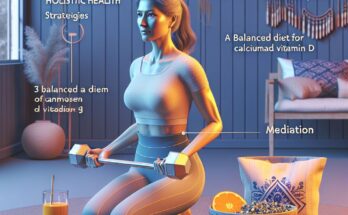Navigating menopause can bring about various physical challenges, including chronic pain. In our article we explore natural and effective ways to alleviate pain during this transition. Learn about nutrition, exercise, and mindfulness techniques that can help manage discomfort and promote overall well-being. Embrace a holistic approach to pain management and discover strategies to enhance your quality of life during and after menopause.
Key Takeways
- Holistic approaches can provide natural pain relief during menopause and beyond.
- Key strategies include herbal remedies, mind-body techniques, and nutritional adjustments.
- Physical activity and restorative sleep are essential components of pain management.
- It’s important to stay hydrated to alleviate joint pain.
- Always consult with a healthcare professional before starting any new treatment.
Understanding Menopausal Changes and Pain
Menopause marks a significant shift in a woman’s life, often bringing with it a host of uncomfortable symptoms. Joint pain, one of the lesser talked about yet common symptoms, can significantly impact quality of life. But why does it happen? As estrogen levels drop, inflammation can increase, leading to discomfort in joints. Understanding this change is the first step towards managing it effectively.
The Role of a Well-Balanced Lifestyle
A well-balanced lifestyle is like the foundation of a house – it supports everything else. For managing menopause-related pain, this includes a healthy diet, regular physical activity, stress reduction, and good sleep hygiene. These aren’t just good habits; they’re powerful tools that can reduce inflammation and improve your overall well-being.
Key Holistic Strategies for Pain Relief
When we talk about holistic strategies, we’re looking at the whole picture – mind, body, and spirit. It’s not just about popping a pill for the pain; it’s about making lifestyle changes that help manage the pain at its source. Let’s dive into some of these strategies that can make a real difference.
Herbal Remedies That Soothe
Nature has provided us with a bounty of herbs that can help soothe menopausal symptoms, including pain. These aren’t just old wives’ tales – many have been backed by scientific research.
Black Cohosh: A Natural Estrogen?
Black cohosh is a plant that’s been used for centuries to treat women’s health issues. Some believe it can act like estrogen in the body, potentially easing hormone-related symptoms. Here’s how to use it:
- Look for standardized extracts of black cohosh root.
- Begin with a low dose to see how your body reacts.
- Be patient – it may take several weeks to notice a difference.
Evening Primrose Oil for Nerve Pain
Evening primrose oil is rich in gamma-linolenic acid (GLA), which can help reduce inflammation. Women have reported relief from nerve pain and breast tenderness when using this oil. To try it:
- Opt for high-quality, cold-pressed evening primrose oil supplements.
- Follow the dosage instructions on the label or consult with your healthcare provider.
Ginseng: A Boost for Vitality
Ginseng is another herb that’s been studied for its potential to alleviate menopausal symptoms. It’s known for boosting vitality and may help with the fatigue that often accompanies pain. Here’s what to keep in mind:
- There are different types of ginseng, like American and Korean, each with unique properties.
- Start with a modest dose to assess your tolerance.
- Take breaks from using ginseng to prevent potential side effects.
Remember, while these remedies can be helpful, they’re not a one-size-fits-all solution. It’s essential to talk to your healthcare provider before trying any new supplement, especially if you’re taking other medications.
Mind-Body Techniques That Connect
It’s not just the body that needs attention during menopause; the mind plays a crucial role in how we experience pain. Mind-body techniques can reduce stress, which in turn can alleviate the intensity of pain. These methods encourage relaxation, improve mood, and can even alter the perception of pain.
Engaging in these practices regularly can create long-lasting changes in your daily life. They can help you become more aware of your body’s signals, giving you a greater sense of control over your menopausal symptoms. Let’s explore some effective mind-body techniques.
Yoga: More Than Just Poses
Yoga is a treasure trove of benefits for menopausal women. It combines physical postures, breathing exercises, and meditation to create a holistic workout that can alleviate joint pain and reduce stress. Here’s how to get started:
- Choose a yoga style that focuses on gentle movements and relaxation, such as Hatha or Yin yoga.
- Incorporate poses that are known for their soothing effect on the joints, like the Child’s Pose or Cat-Cow Stretch.
- Practice consistently, even if it’s just for a few minutes a day, to see continuous benefits.
Yoga is adaptable for all fitness levels, so don’t worry if you’re not flexible or have never tried it before. It’s about connecting with your body and finding what feels good for you.
Meditation: Finding Mental Relief
Meditation is like a pause button for your mind. It allows you to take a step back from the chaos and just breathe. Regular meditation can lower stress hormones, which may help reduce the perception of pain. Here’s a simple way to start:
- Find a quiet space where you won’t be interrupted.
- Sit comfortably and close your eyes, focusing on your breath.
- When your mind wanders, gently bring your focus back to your breathing.
Even just five minutes of meditation a day can make a difference. It’s about quality, not quantity. Consistency is key.
Acupuncture: An Ancient Tool for Modern Healing
Acupuncture is a centuries-old practice that involves inserting thin needles into specific points on the body to restore balance and encourage healing. It’s thought to stimulate the nervous system and release pain-relieving chemicals. Here’s what to consider:
- Seek out a licensed acupuncturist with experience in treating menopausal symptoms.
- Be open and communicate with your acupuncturist about your pain and concerns.
- Give it time – it may take several sessions to notice improvements.
Acupuncture is generally considered safe when performed by a trained professional, and many find it to be a relaxing experience.
Nutritional Adjustments for Pain Management
What you eat can have a profound impact on how you feel. During menopause, your body’s needs change, and so should your diet. Anti-inflammatory foods can help reduce joint pain, while certain nutrients can support overall bone and joint health. Let’s look at some key dietary changes that can help manage pain.
Essential Nutrients to Combat Pain
Ensuring you’re getting the right nutrients is vital for managing menopausal pain. Calcium and vitamin D are crucial for maintaining bone health, while omega-3 fatty acids can help reduce inflammation throughout the body. Here’s how to incorporate them into your diet:
Calcium & Vitamin D: Building Strong Bones
Calcium and vitamin D work together to keep your bones strong and healthy. Here are some calcium-rich foods to include in your diet:
- Dairy products like milk, cheese, and yogurt
- Leafy green vegetables such as kale and broccoli
- Fortified foods, like certain cereals and plant-based milk
Vitamin D is also essential, as it helps your body absorb calcium. You can get vitamin D from:
- Exposure to sunlight
- Fatty fish like salmon and mackerel
- Fortified foods and supplements
Omega-3 Fatty Acids: Reducing Inflammation
Omega-3 fatty acids are well-known for their anti-inflammatory properties. Incorporating them into your diet can help manage pain and stiffness associated with menopause. Here’s where you can find them:
- Fatty fish, such as salmon, mackerel, and sardines
- Flaxseeds and chia seeds
- Walnuts
- Supplements, if you’re not getting enough from food
Hydration: The Simple Elixir for Joint Pain
Never underestimate the power of water. Staying well-hydrated helps keep your joints lubricated, which can ease pain and improve mobility. Aim for at least eight 8-ounce glasses of water a day, and remember that fruits and vegetables also contribute to your hydration levels.
Hydration is especially important if you’re dealing with hot flashes or night sweats, as they can increase your risk of dehydration. So, keep a water bottle handy and sip throughout the day.
Physical Activity: Movement as Medicine
Exercise might be the last thing on your mind when you’re in pain, but it’s one of the best things you can do for your body during menopause. Regular physical activity can strengthen muscles, improve flexibility, and reduce joint pain. Here’s how to make exercise work for you:
Choose low-impact activities that you enjoy, such as walking, swimming, or cycling. These can provide the benefits of exercise without putting too much strain on your joints.
Start slow and gradually increase the intensity and duration of your workouts. Listen to your body and rest when you need to. It’s about finding a balance that works for you.
Remember, consistency is more important than intensity. Even a daily 15-minute walk can make a significant difference in how you feel.
Physical Activity: Movement as Medicine
Engaging in regular physical activity is essential during menopause and post-menopause, not only for managing pain but for enhancing overall health. Exercise helps maintain a healthy weight, reduces the risk of chronic diseases, and improves mental health, which can all contribute to a reduction in menopausal symptoms, including pain.
Exercise: Your Key to Easing Pain
Low-impact exercises such as walking, swimming, and yoga can strengthen the muscles around your joints, increase flexibility, and reduce stiffness. They can also help improve your mood and sleep, which may be affected by menopause. Here’s how to get started:
First, choose activities that you enjoy, which will make it easier to stick with your exercise routine. Next, set realistic goals and build up the intensity and duration of your workouts gradually. And most importantly, listen to your body. If something hurts, stop and rest. Consistent, moderate activity is more beneficial than occasional, intense exercise.
Restorative Sleep Patterns
Quality sleep is vital for pain management. Poor sleep can make you more sensitive to pain and can contribute to fatigue and mood changes. Here’s how to improve your sleep:
Establish a regular sleep schedule by going to bed and waking up at the same time every day. Create a relaxing bedtime routine, such as reading or taking a warm bath, to signal to your body that it’s time to wind down. Keep your bedroom cool, dark, and quiet, and avoid caffeine and screens before bedtime.
- Create a sleep-conducive environment that is dark, quiet, and cool.
- Avoid stimulants such as caffeine and nicotine close to bedtime.
- Establish a calming pre-sleep routine to help you relax.
- Be consistent with your sleep schedule, even on weekends.
- Limit daytime naps if they interfere with nighttime sleep.
Restorative sleep can help your body repair itself and is crucial for managing pain and other menopausal symptoms.
FAQs
Here are some frequently asked questions about holistic pain management during menopause and post-menopause.
How can I start integrating holistic practices into my life?
Start small by incorporating one or two practices, such as yoga or meditation, into your daily routine. Gradually add more as you become comfortable. Remember, the goal is to create a sustainable, holistic approach to your health that you can maintain long-term.
Are there any risks to natural remedies?
While many natural remedies are safe, they can interact with medications and have side effects. It’s essential to consult with a healthcare provider before starting any new treatment, especially if you have underlying health conditions or are taking other medications.
Research the remedies you’re interested in and purchase them from reputable sources to ensure quality and purity.
How long does it take to see results from holistic treatments?
It varies depending on the treatment and the individual. Some people may notice improvements within a few weeks, while for others, it may take longer. Consistency and patience are key when trying new holistic treatments.
Keep in mind that holistic treatments often work best when combined with other healthy lifestyle choices, such as a balanced diet and regular exercise.
Can holistic pain management replace conventional medicine?
For some women, holistic pain management techniques can significantly reduce the need for conventional medicine. However, it’s crucial to work with a healthcare provider to determine the best approach for your specific situation. Never stop taking prescribed medications without consulting your doctor.
- Work with a healthcare provider to develop a comprehensive pain management plan.
- Use holistic methods as complementary treatments alongside conventional medicine.
- Regularly assess your pain levels and adjust your plan as needed.
Combining holistic and conventional treatments often provides the best results.
Is it safe to mix herbal remedies with traditional medication?
It’s important to be cautious when combining herbal remedies with traditional medications. Some herbs can interact with medications, potentially causing adverse effects or reducing the effectiveness of the medication.
Always discuss any herbal supplements with your healthcare provider to ensure they are safe to use with your current medications and health conditions.
Remember, menopause is a natural phase of life, and with the right strategies, you can manage pain and maintain a vibrant, healthy lifestyle. Embrace these holistic approaches as part of your journey to wellness, and don’t hesitate to seek support from healthcare professionals, friends, and family along the way.



